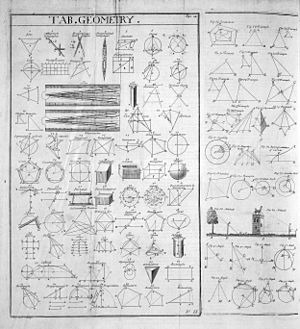
Back تاريخ الهندسة الرياضية Arabic Historia de la xeometría AST জ্যামিতির ইতিহাস Bengali/Bangla Geschichte der Geometrie German Historia de la geometría Spanish تاریخ هندسه Persian Histoire de la géométrie French ज्यामिति का इतिहास Hindi Երկրաչափության պատմություն Armenian 기하학사 Korean

| Geometry |
|---|
 |
| Geometers |
Geometry (from the Ancient Greek: γεωμετρία; geo- "earth", -metron "measurement") arose as the field of knowledge dealing with spatial relationships. Geometry was one of the two fields of pre-modern mathematics, the other being the study of numbers (arithmetic).
Classic geometry was focused in compass and straightedge constructions. Geometry was revolutionized by Euclid, who introduced mathematical rigor and the axiomatic method still in use today. His book, The Elements is widely considered the most influential textbook of all time, and was known to all educated people in the West until the middle of the 20th century.[1]
In modern times, geometric concepts have been generalized to a high level of abstraction and complexity, and have been subjected to the methods of calculus and abstract algebra, so that many modern branches of the field are barely recognizable as the descendants of early geometry. (See Areas of mathematics and Algebraic geometry.)
- ^ Howard Eves, An Introduction to the History of Mathematics, Saunders: 1990 (ISBN 0-03-029558-0), p. 141: "No work, except The Bible, has been more widely used...."
© MMXXIII Rich X Search. We shall prevail. All rights reserved. Rich X Search